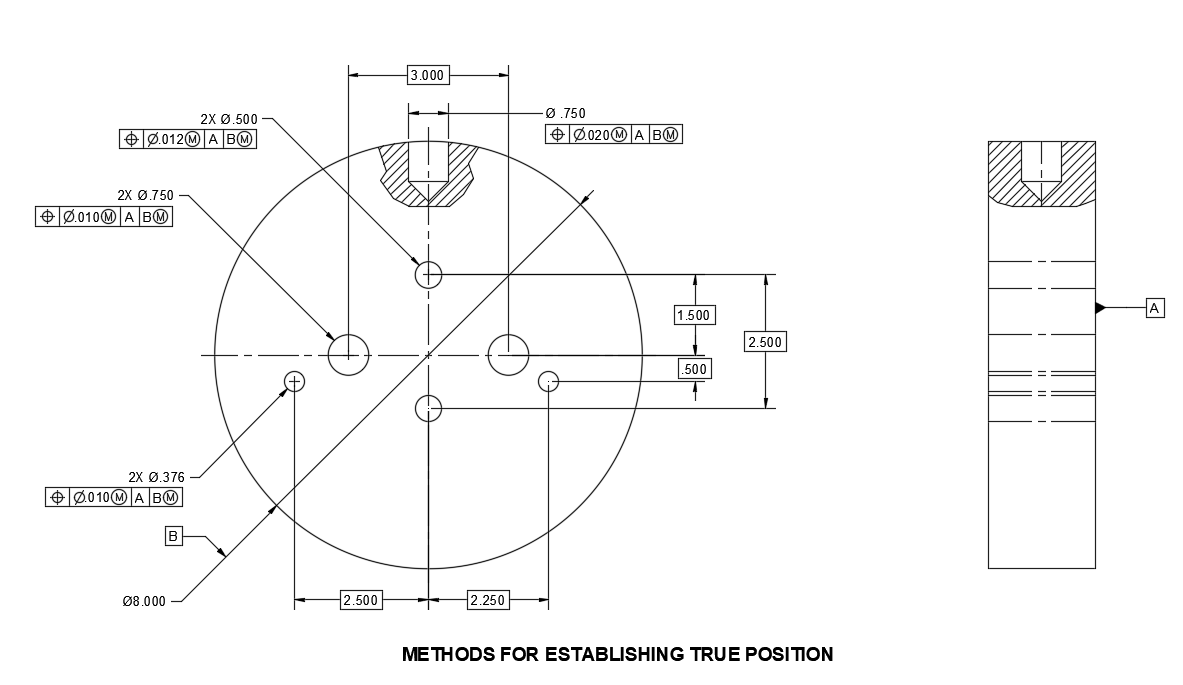Located to the center plane of the slot width with a basic dimension in one axis, radius ends are implied on center in the other. The overall size of the slot is bilateral toleranced in both directions (±0.5mm) and the ends to be FULL R. Engineering & Design: Geometric Dimensioning 5 SECTION5 Section Contents NADCA No. Format Page 1 Introduction 5-2 2 What is GD&T? 5-2 3 Why Should GD&T be Used? 5-3 4 Datum Reference Frame 5-4 4.1 Primary, Secondary, Tertiary Features & Datums 5-4 4.2 Datum Feature Vs. Datum Plane 5-5 4.3 Datum Plane Vs. Datum Axis 5-5 4.4 Datum Target Sizes.
Design engineers, machinists, toolmakers, mold makers, quality inspectors, etc. are all fundamental players that help transform concepts into functional parts throughout the production journey. The key to achieving great results is to ensure that all these individuals communicate clearly, and that's where Geometric Dimensioning and Tolerancing (GD&T) comes into play.
Introduction to GD&T
GD&T is a language of symbols and principles designed to facilitate communication between professionals that must work together in order to manufacture something. The goal of this mathematical language is to describe a part's geometry and the allowable tolerance for variation. When properly implemented, GD&T can reduce the number of notes, dimensions and tolerances required on a drawing and its application has proven to reduce cost and improve quality, reliability and safety.
There are two principal standards of GD&T in use globally, ASME and ISO. The ASME standard is used to define the proper application of the language in the U.S., while the ISO standard is used by the rest of the world.
The Basics of GD&T
At a first sight, GD&T language can seem complex and quite intimidating as the list of symbols used for defining part dimensions and tolerances is pretty extensive. To simplify the learning process, most courses and guides typically break down the information into basic concepts. Let's take a look at them.

GD&T Symbols
Symbols, or geometric characteristics, are the first thing that typically comes to mind when talking about GD&T. There are 14 different symbols included in the language that are commonly used to describe each shape characteristic or tolerance that GD&T can describe. You can find a quick guide to the symbols here.
Machining tolerances
Tolerance is the allowable amount of deviation from the proposed drawing. Machined parts look flat and straight through the naked eye, but if viewed with calipers, one can find imperfections all over. These imperfections or variations are allowed within the tolerance constraints placed on the parts. Tolerances should preserving the functions of the part.
Datum Reference Frames
The datum reference frame (DRF) is one of the most important aspects of GD&T. It describes the coordinate system against which the geometric dimensions and tolerances of a part are defined, and its main function is to specify a foundation for the inspection of the part.
Gd T Dimensioning A Slot
There's an important distinction between datum and datum features. A datum is a theoretical exact plane, point or axis location from where dimensional measurements are taken. A datum is denoted in capital alphabetic letters and is tied to the datum feature with a black, color filled triangle as shown below.
Image credit: gdandtbasics.com
Datum features are the actual physical features (holes, faces, slots, etc.) on the part.
Material Condition Modifiers
Material condition modifiers are used to specify how the tolerance zone is affected by other tolerances that apply to a feature. For example, when a feature is designed to be fitted with another feature, such as a pin or a hole, the tolerances for the size and position affect the result. There are three material condition modifiers:
- Maximum Material Condition (MMC): This modifier describes a feature that contains the greatest amount of material yet remains within its tolerance zone. For holes, this means the smallest the hole can be for the corresponding pin to fit. For pins, this means the largest the feature can be to fit into the corresponding hole.
- Least Material Condition (LMC): This describes a feature that contains the least amount of material. For holes, this means the largest the hole can be for the corresponding pin to fit. For pins, this means the smallest the feature can be to fit into the corresponding hole.
- Regardless of Feature Size (RFS): RFS could refer to any increment of size for any feature within its size tolerance.
Feature Control Frame
The feature control frame (FCF) includes all the information listed above. It states the requirements or instructions for the feature to which it attached.


A typical FCF consists of different compartments in which geometric characteristic symbols, tolerance values, datum references, and modifiers are placed.
Recommended Resources
As we mentioned above, GD&T is a complex language and the information included in this short guide is just the tip of the iceberg. The best way to learn how to use and read it is, as always, by combining the information contained in textbooks with real-world practice. We did some research and made a short list of books that we recommend keeping on hand. Since most of our readers are in the U.S., the reference guides listed in this article are focused on the ASME standard. Here are our recommendations:
Dimensioning A Slot Gdt
ORDER NOW
If you are just getting started with GD&T, this book is your go-to. This standard establishes symbols, rules, definitions, requirements, defaults, and recommended practices for stating and interpreting dimensioning, tolerancing, and related requirements for use on engineering drawings, models defined in digital data files, and related documents.
ORDER NOW

GD&T Symbols
Symbols, or geometric characteristics, are the first thing that typically comes to mind when talking about GD&T. There are 14 different symbols included in the language that are commonly used to describe each shape characteristic or tolerance that GD&T can describe. You can find a quick guide to the symbols here.
Machining tolerances
Tolerance is the allowable amount of deviation from the proposed drawing. Machined parts look flat and straight through the naked eye, but if viewed with calipers, one can find imperfections all over. These imperfections or variations are allowed within the tolerance constraints placed on the parts. Tolerances should preserving the functions of the part.
Datum Reference Frames
The datum reference frame (DRF) is one of the most important aspects of GD&T. It describes the coordinate system against which the geometric dimensions and tolerances of a part are defined, and its main function is to specify a foundation for the inspection of the part.
Gd T Dimensioning A Slot
There's an important distinction between datum and datum features. A datum is a theoretical exact plane, point or axis location from where dimensional measurements are taken. A datum is denoted in capital alphabetic letters and is tied to the datum feature with a black, color filled triangle as shown below.
Image credit: gdandtbasics.com
Datum features are the actual physical features (holes, faces, slots, etc.) on the part.
Material Condition Modifiers
Material condition modifiers are used to specify how the tolerance zone is affected by other tolerances that apply to a feature. For example, when a feature is designed to be fitted with another feature, such as a pin or a hole, the tolerances for the size and position affect the result. There are three material condition modifiers:
- Maximum Material Condition (MMC): This modifier describes a feature that contains the greatest amount of material yet remains within its tolerance zone. For holes, this means the smallest the hole can be for the corresponding pin to fit. For pins, this means the largest the feature can be to fit into the corresponding hole.
- Least Material Condition (LMC): This describes a feature that contains the least amount of material. For holes, this means the largest the hole can be for the corresponding pin to fit. For pins, this means the smallest the feature can be to fit into the corresponding hole.
- Regardless of Feature Size (RFS): RFS could refer to any increment of size for any feature within its size tolerance.
Feature Control Frame
The feature control frame (FCF) includes all the information listed above. It states the requirements or instructions for the feature to which it attached.
A typical FCF consists of different compartments in which geometric characteristic symbols, tolerance values, datum references, and modifiers are placed.
Recommended Resources
As we mentioned above, GD&T is a complex language and the information included in this short guide is just the tip of the iceberg. The best way to learn how to use and read it is, as always, by combining the information contained in textbooks with real-world practice. We did some research and made a short list of books that we recommend keeping on hand. Since most of our readers are in the U.S., the reference guides listed in this article are focused on the ASME standard. Here are our recommendations:
Dimensioning A Slot Gdt
ORDER NOW
If you are just getting started with GD&T, this book is your go-to. This standard establishes symbols, rules, definitions, requirements, defaults, and recommended practices for stating and interpreting dimensioning, tolerancing, and related requirements for use on engineering drawings, models defined in digital data files, and related documents.
ORDER NOW
Based on the ASME Y14.5-2018 Dimensioning and Tolerancing standard, this highly-illustrated book contains topics ranging from the fundamentals of dimensioning to the extended principles of tolerance application and interpretation.
ORDER NOW
This textbook has been written for anyone whose work requires them to communicate, interpret or manufacture products through the use of engineering drawings and/or CAD models that use GD&T.
ORDER NOW
Still based on the ASME Y14.5-2009 standard, this guide is one of the most popular GD&T references among machinists. Spiral bound and pocket-sized, the Ultimate GD&T Pocket Guide is the perfect on-the-job reference for any geometric dimensioning and tolerancingGD&T needs.
ORDER NOW
This book (typically paired with the pocket guide mentioned above) clearly organizes GD&T fundamentals into small, logical units for a step-by-step instruction.
This post may contain affiliate links. Please read our disclosurefor more info.
How to win at online roulette every time. In roulette, there are certain tips and tricks that can stand you in good stead of winning some serious cash. You just need to know how to play the system! In this article, we will explain exactly how to win at roulette, leaving you with more money on the table and off it. Outside bets offer the best odds of winning at roulette. These types of wagers are placed on groups as opposed to just numbers, for example odd or even, red or black, 1-18 or 19-46, dozen bets,. None of these are guaranteed to help you win every time. Roulette is one of the most popular sports in a casino and one that attracts a lot of players. As long as you remember that the long shot bets are that – long shots – you can put some of the strategies here into practice and use these roulette tips to win.

